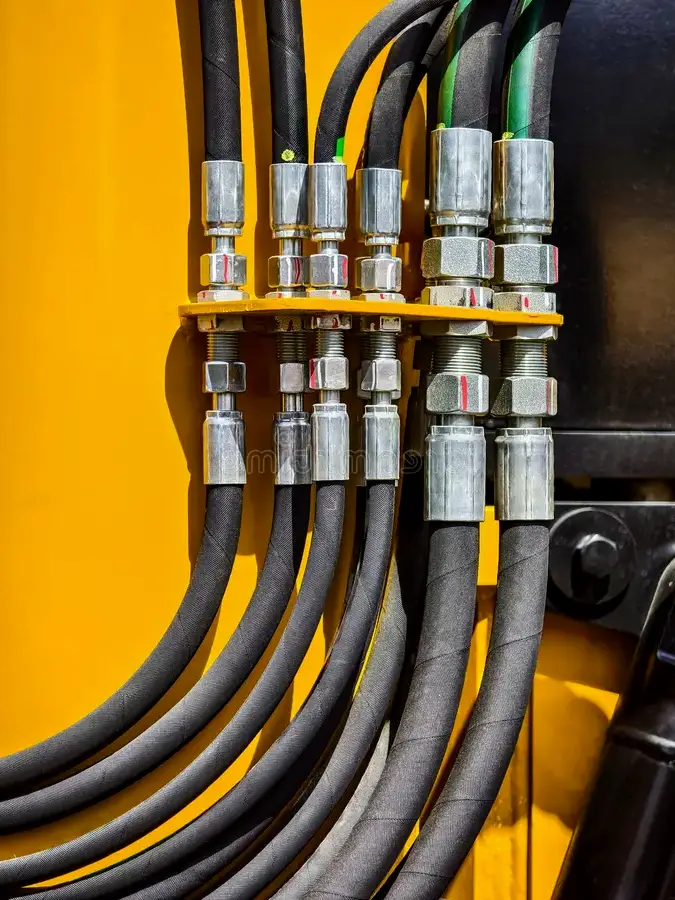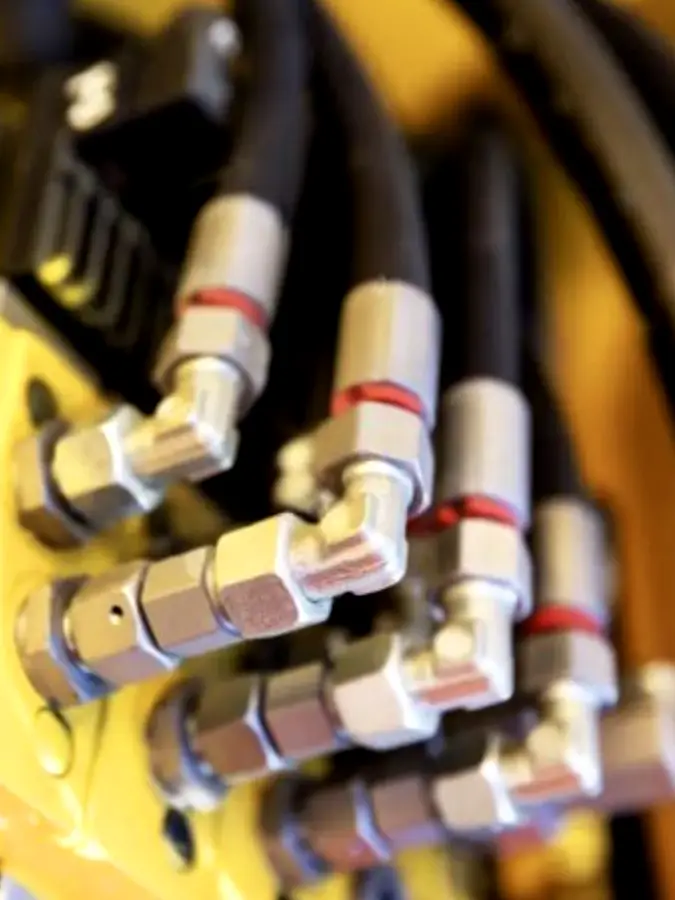At Kingdaflex, we provide forklift hydraulic hoses. These essential components ensure smooth and efficient operation of your equipment. Our hoses are designed for durability, flexibility, and resistance to wear and tear, minimizing downtime and maximizing productivity.
Durable and abrasion-resistant for demanding warehouse environments.
Flexible design allows for easy routing in confined spaces.
Engineered for optimal flow, ensuring efficient lift cycles.
Reinforced construction to handle high-pressure hydraulic systems.
Long-lasting performance reduces downtime and maintenance costs.
For optimal performance and safety, it’s crucial to use compatible forklift hydraulic hoses. Consult us a qualified hydraulics specialist for proper selection and installation.
We help you select the ideal hydraulic hose for your forklift’s specific needs. We offer hoses engineered to handle the required pressure, temperature, and fluid type, ensuring your equipment operates safely and efficiently. Our experts guide you through options like the SAE 100R7 or SAE 100R8 series for optimal performance.
We supply a wide range of fittings that are meticulously matched to your chosen hose. Our fittings are made from robust materials and are designed to create a secure, leak-proof connection. Using the right fittings is essential for safety and prevents costly blowouts under pressure.
We provide precise measurement services to ensure you get the perfect fit. Our team helps you determine the correct inner diameter and length, which are critical for maintaining proper fluid flow and preventing kinking. A correctly sized hose reduces stress and extends its service life.
We guarantee that all our forklift hydraulic hoses meet stringent industry standards. Our products are tested for burst pressure, abrasion resistance, and flexibility to ensure they perform reliably in demanding environments. We provide certifications to give you confidence in the safety and durability of your purchase.
At Kingdaflex, you’ll find a complete range of hydraulic hoses for forklifts, with options suitable for both standard and more complex applications. We offer hoses specially designed to cope with high pressure, hoses with specific bending radiuses, and more. These are available in a variety of materials including rubber, thermoplastic, and polytetrafluoroethylene (PTFE). All of our forklift hydraulic hoses comply with international standards.
Need to replace a hose in a forklift’s hydraulic system? We offer a wide range of hydraulic hoses, with options suitable for every type of forklift and application. At Kingdaflex, we keep a lot of stock on hand, so fast delivery is guaranteed.
If you have questions about which forklift hydraulic hose is best for your needs, please contact us! Our highly skilled team is more than happy to help.

Safety First: Always secure the forklift and release all hydraulic pressure before beginning work. This is a critical step to prevent serious injury.
Identify the Problem: Visually inspect for abrasion, leaks, bulges, or cracks. These signs indicate a compromised hose that requires immediate replacement.
Correct Components: Use a new hydraulic hose with the same specifications (size, pressure rating, length) and matching fittings for a perfect fit.
Professional Installation: A qualified technician should perform the replacement. They have the right tools and expertise to crimp new fittings and ensure a secure, leak-free connection.
Final Inspection: After installation, slowly re-pressurize the system and carefully check the new hose and fittings for any signs of leaks.
Increased Safety: Engineered for high pressure, reducing the risk of sudden leaks or catastrophic failure during operation.
Enhanced Durability: Built with a reinforced cover to resist abrasion, impacts, and environmental damage common in warehouses.
Improved Efficiency: Designed with a smooth bore for optimal fluid flow, ensuring quick and responsive forklift control.
Reduced Maintenance: A longer lifespan and resistance to wear and tear mean less frequent replacements and lower service costs.
Optimal Flexibility: Allows for a tighter bend radius, simplifying installation and routing in the forklift’s confined spaces.

The length of a hydraulic hose depends entirely on the specific application. Here’s why:
System Design:
Application:
Key Considerations:
Determining the Correct Length:
Important Note: Always use the correct hose length for optimal performance, safety, and longevity of your hydraulic system.
The forklift hydraulic hose replacement can be a complex task and should only be performed by a qualified technician. However, here’s a general overview of the steps involved:
This is a general overview of the process, and the specific steps may vary depending on the make and model of the forklift. It is important to consult the manufacturer‘s service manual for detailed instructions and safety precautions.
If you are not confident in your ability to replace a hydraulic hose on your forklift, it is best to hire a qualified technician to do the job for you.
Here are some factors that influence hydraulic hose replacement schedules:
Usage:
Operating Conditions:
Hose Material:
Maintenance:
General Guidelines:
Preventative Replacements:
Replace Immediately:
Key Takeaway:
Regular inspections and a proactive maintenance approach are essential for maximizing the lifespan of your hydraulic hoses and minimizing downtime. Consult with a hydraulics specialist or refer to the equipment manufacturer‘s recommendations for specific guidance on replacement intervals.
Hydraulic hoses on a forklift are typically located in several key areas:
Finding Specific Hoses:
Important Note: Working with hydraulic systems requires caution. Always refer to the operator’s manual and consult with a qualified technician for any repairs or maintenance.
Hydraulic hose failures can stem from a variety of factors:
Abrasion: Rubbing against sharp edges, other hoses, or equipment components wears down the outer cover, exposing the inner layers.
Kinking: Bending the hose beyond its minimum bend radius damages the inner tube, leading to leaks and potential bursts.
High Temperatures: Excessive heat can degrade the hose materials, causing them to harden, crack, and become brittle.
Low Temperatures: In extreme cold, hoses can become stiff and inflexible, increasing the risk of cracking or splitting.
Chemical Exposure: Contact with incompatible chemicals can weaken or dissolve the hose materials.
Internal Pressure: Exceeding the hose’s pressure rating can cause it to burst.
Improper Installation: Incorrect fitting installation, improper crimping, and inadequate support can lead to premature failure.
Age and Wear: Over time, hoses naturally deteriorate due to age, fatigue, and exposure to the elements.
Fluid Contamination: Contaminated hydraulic fluid can accelerate hose wear and damage internal components.
Improper Routing:
Poorly routed hoses are more susceptible to damage from abrasion, kinking, and excessive strain.
It’s crucial to regularly inspect hoses for signs of wear and tear and replace them promptly if any issues are detected.